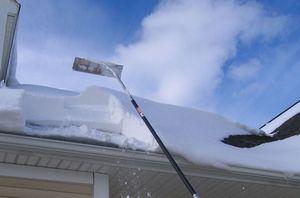
If not cleared off, dry, fluffy snow piled on roofs can act as a sponge, absorbing any additional sleet and rain, adding weight and stress to structures. Flat, commercial roofs are most susceptible if they are not draining properly. Additionally, MEMA encourages citizens to clear storm drains in their neighborhoods to minimize local flooding problems from rainfall.
In many cases, roof ice dams can form causing water build-up, leading to interior damage. To minimize the risk of over-stressing a building roof due to accumulated or drifting snow:
-If roof snow can be removed, from the ground, with the use of a snow rake (available at most hardware stores), do so. Use caution, as metal snow rakes conduct electricity if they come into contact with a power line.
-Try to avoid working from ladders, as ladder rungs tend to ice up. Snow and ice collect on boot soles, and metal ladders.
-Flat roofs can be shoveled clear, but only if it is determined that the roof is safe to stand upon. Exercise care when on the roof to avoid potentially dangerous falls.
-Flat roof drainage systems should be kept clear to minimize the risk of excess roof ponding in the event of subsequent heavy rainfall or melting.
-Large icicles can form on roof overhangs, but do not necessarily mean ice damming is occurring. Icicles overhanging doorways and walkways can be dangerous and should be carefully removed.
-All of the mentioned actions should only be performed by able-bodied adults, as the snow is heavy, and roofs and other surfaces may be slippery. Protective headgear and eye protection is recommended.
-Be on the alert for large accumulating snow build-up or snowdrifts on your roofs.















